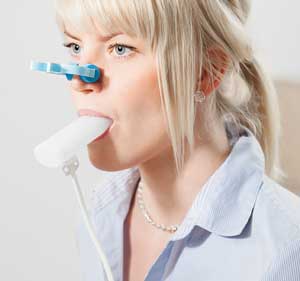What to look for when buying a Spirometry Machine
Choosing the right Spirometry unit for your practice is an important decision that shouldn’t be taken lightly. After all, you need a device that matches the needs of your practice. Today, health care professionals have a range of Spirometry units they can choose from. However, all this choice, such as PC Based or Stand Alone, filtered mouthpieces or cardboard mouthpieces, “Professional” models or “Standard Models” can make, making the right decision difficult.
PC Based
As a starting point, it is usually easiest to start with deciding whether you require a PC Based or Standalone Spirometer. PC Based, as it suggests, means that the Spirometry unit connects to a computer/tablet via USB (usually requires Windows) for it to work. The USB connection powers the device, and the software that comes with the device is what takes and stores the results. The main benefit here is a paperless system with results stored in the software. Often the user can then save the results as a PDF and import them into the patients file with their chosen Electronic Medical Records (EMR) software. Some devices even offer integration where the Spirometry Software can integrate with your EMR programs such as Best Practice or Medical Director. This allows the results to be stored in the patient’s record instantly. Other things to consider is the mobility of a PC Based Spirometer as it must have its own software to function. You need to check that software can be installed freely onto other computers in your practice if you require it to be used in multiple rooms. Consider how your network is set up and if the device you are considering can work with that setup.
Today, health care professionals have a range of Spirometry Units to choose from.

Stand-alone Spirometers, while no longer as prominent in the market, still have their benefits. They normally only require a power point (along with basic accessories such as mouthpiece and paper) to work anywhere. This mobility can be attractive for many customers who find they might often be offsite performing tests. Also, if your practice still prefers paper over digital results, stand-alone units might be for you. While more basic compared to the PC Based machine, the stand-alone unit doesn’t often require the user to deal with the installation of software which can at times be confusing and time-consuming. Lastly, paper for your results is an ongoing cost not associated with PC Based units. Keep this in mind when making your decision.
Mouthpieces
The major cost of running a Spirometry test (apart from the Doctor’s or Nurse’s time) are the mouthpieces. These days there is a range of mouthpieces available but to keep it simple, we can break them into two groups, Filtered and Cardboard (Non-Filtered). Filtered mouthpieces have the benefit of being the standard when it comes to infection control in spirometry testing. They will have a filtered membrane with a bacterial and viral efficacy approximately greater than 99%. These are by far becoming the most popular option among healthcare professionals. However, their costs are considerably higher than the standard Cardboard mouthpieces which offer very little infection control. Filtered pieces can range from $2 and up to $5 depending on the make and model whereas cardboard pieces can be as low as 25c each. However, healthcare professionals appear to be moving away from the cheaper option, suggesting that there is greater value in reducing the risk of infection compared to the savings from the cheaper mouthpieces. The last consideration is that filtered mouthpieces also extend the life of your Spiromter’s turbine due to catching most bacteria and bodily fluids. This means less maintenance or replacement of parts.
For more information, we always recommend speaking to a sales representative who can answer any further questions you might have. They can even demo some of our Spiro’s for you.
Standard or Professional
You will also find that a range of spirometry units have a range of features that can create two or three different versions of what looks like the same device. This is advertised in a way that suggests the hardware (the physical part of the machine) is the same and then depending on what model (standard or professional) you choose, means you get less or extra features such as limited or additional parameters. Note that almost all spirometry units, both stand-alone and PC Based offer enough parameters and features for a General Practioner to successfully use, diagnose and claim the rebate of $34.95 (Medicare Item Number 11505).Pro Models as they can be described often appeal to respiratory specialists where additional features such as inbuilt humidifier and temperature features (helps with accuracy) or a large number of parameters become more relevant than to that of a GP, however, if the absolute best for accuracy is what you are after, than a “Professional” model could be right. Overall it is important to ask yourself what works best. Consider a device that is quick and easy so that it limits the time it takes for a test to take place. PC Based unit also offers time savings with results stored digitally for easy access and archiving. This will allow yourself or your staff to focus on other tasks and lower the actual running cost of your device. For more information, we always recommend speaking to a sales representative who can answer any further questions you might have. They can even demo some of our Spiro’s for you. Below is a range of Spirometers we recommend, both PC Based and stand-alone.
